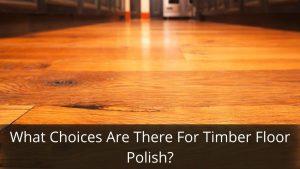What are the best timber floor polishes?
Choices for timber floor polish are many. You can choose from a variety of oils, waxes or polyurethanes. These finishes all provide different levels of protection and durability to the floor. The oils are easy to apply and offer a natural look that is popular with many people. They also provide some protection against scuffs, scratches and other abrasions on the floor’s surface. The waxes are also easy to apply and they provide a little more protection against scuffs, scratches and other abrasions on the floor’s surface. They give the floor an attractive shine that is also popular with many people.

The polyurethanes are the most durable of all the finishes available for timber floors. They provide maximum protection against scuffs, scratches and other abrasions on the floor’s surface. They also give the floor a very high shine that is popular with many people. A number of different finishes are available for timber floors and each one provides its own benefits to the floor. They all provide a protective coating that helps to maintain the integrity of the timber while also making it more resistant to scuffs, scratches and other abrasions on its surface.
The finishes available for timber floors include:
1. Waxes – Waxes are among the oldest of all finishes available for timber floors and they also provide one of the most natural appearances to a floor. Many people prefer wax for its ability to be easily applied and removed, as well as the fact that it is very easy to maintain.
2. Oils – Oil finishes are also popular with many people because of their natural appearance, but they do tend to be a little more difficult to apply than waxes. Oils also take longer to dry and cure than some other finishes available for timber floors.
3. Shellac – Another popular finish for timber floors is shellac, which is created from resin secreted by an insect known as the lac bug. This type of finish will typically last between 6-12 months, depending on how well it is applied and maintained.
4. Lacquer – Lacquer finishes are also very popular with many people because they are easy to apply and remove, and they do not require the use of solvents.
What are the different types of timber floor polishes?
There are a range of different types of timber floor polishes, including: hard waxes, soft waxes and sealants. Hardwax is the most common type used on wood floors, which is a natural substance that can be used to bring out the beauty of wood. Softwaxes are typically applied over hard wax, as they provide an extra layer of protection and make the floor easier to clean. Sealants are usually used on floors that have been recently sanded or refinished, as they can help to fill in any small scratches and imperfections.
What are the benefits of using a timber floor polish?
There are many benefits of using a timber floor polish. For example, it can make the wood look shinier and more beautiful than ever before. The shine on the wooden surface will be different and more attractive than the natural look of untreated wood. Another benefit is that a polish can give timber an extension to its life span, and make it last longer before needing replacement or repairing. The polish can also be used to protect the wood from scratches and other damage. It is important that you choose a polish that will suit your needs and preferences. If you want to achieve a certain look, you have to choose the right polish.
How do I choose the right timber floor polish for my home?
Choosing the right timber floor polish for your home is a difficult task. There are so many things to consider, such as what type of wood you have and how it will affect the color of the finish, what type of surface you want and how it will affect the wearability of your timber floor. The first thing to consider is whether you have hardwood or softwood floors.
What are the risks of using a timber floor polish?
One of the biggest risks that come with using a timber floor polish is over-application. When too much polish has been applied, it can damage the wood and create an uneven surface. The best way to avoid this is by applying a thin coat of floor polish and evenly spread it with a clean cloth. The risk of over-application can be avoided through the use of proper technique. The most important thing to remember is that less is more. By using a small amount of polish, you will avoid the risk of over-application and still achieve a great finish on your timber floor. When you have applied the floor polish, it is important to allow it to dry. Some people make the mistake of walking on their floor too soon after applying a coat of polish. It can take up to 24 hours for the polish to dry, so it is best to leave it overnight.
The drying time will vary depending on the type of floor polish you choose. Some can be applied and walked on within 15 minutes, while others may take up to 24 hours. The drying time is also dependent upon the humidity level of your room. If you live in a humid area or have a humidifier running in your home, you should allow extra time for the polish to dry. The most important thing to remember when applying floor polish is that it can take several coats of polish before the floor is completely covered. So, when you are applying the first coat of polish, it may be difficult to tell if you have applied enough or too much.
If your floor feels sticky after you have applied the polish, you can wipe it off with a clean cloth. If there is still some sticky residue on your floor after wiping, wait until the next day to apply another coat of polish. If you have a problem with the polish being sticky, use less oil when mixing the polish. There are many different brands of floor polish available at your local home improvement store.
How often should I polish my timber floor?
If your timber floor is in a high-traffic area, it will require more frequent polishing. This can be done monthly or even weekly if you want to maintain the shine of your floor.
